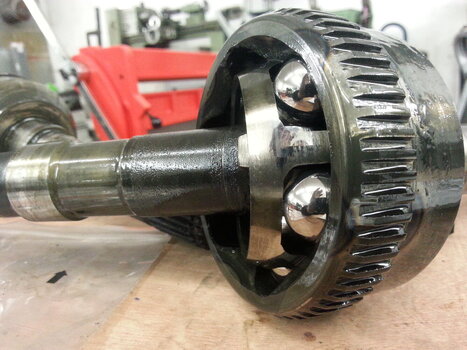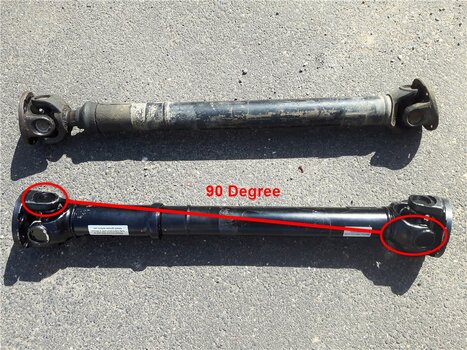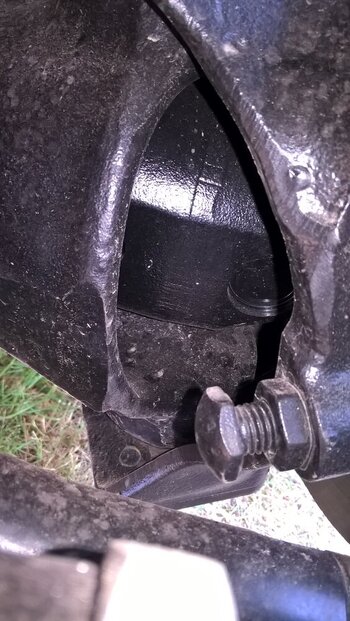Any thoughts on fitting of wheel spacers to the Grenadier? Would this not allow for a tighter turning circle than currently available? What might the trade off be?
The Grenadier Forum
Register a free account today to become a member! Once signed in, you'll be able to contribute to the community by adding your own topics, posts, and connect with other members through your own private inbox! INEOS Agents, Dealers or Commercial vendors please contact admin@theineosforum.com for a commercial account.
You are using an out of date browser. It may not display this or other websites correctly.
You should upgrade or use an alternative browser.
You should upgrade or use an alternative browser.
Wheel spacers
- Thread starter Cheshire cat
- Start date
Wheel spacers are illegal in Australia for a wide variety of reasons, mostly because they are dangerous and can cause considerable extra wear and tear and damage to a vehicle.Any thoughts on fitting of wheel spacers to the Grenadier? Would this not allow for a tighter turning circle than currently available? What might the trade off be?
Trade off:
- More leverage force to the axle. If the swivels are mounted more force on the bolted connection. (BTW: that leads to the question if the axles are "one part" which means the swivels are welded to the axle like with Toyota and others or are they mounted with bolts like the Land Rover ones? If they are one part, you should keep them in best order, otherwise you have to change the whole axle when they get rust and ruin every seal).
- Can have an effect on the suspension, as the leverage force is higher and the distance between the wheel and the spring/damper increases.
- Depending on the homokinetic joint, a smaller turning circle can (must not) have a negative effect. When you're on full turn the steel balls transfering the rotation and torque will move to the outer part of the housing they are in. If then a high torque is required and the outer edge of the housing is not strong enough, it can break. This is the experience with other cars using that system, but it depends on how it is build.
It looks like this, maybe you recognize what I'm talking about (however, the ones on the picture are not damaged):

AWo
- More leverage force to the axle. If the swivels are mounted more force on the bolted connection. (BTW: that leads to the question if the axles are "one part" which means the swivels are welded to the axle like with Toyota and others or are they mounted with bolts like the Land Rover ones? If they are one part, you should keep them in best order, otherwise you have to change the whole axle when they get rust and ruin every seal).
- Can have an effect on the suspension, as the leverage force is higher and the distance between the wheel and the spring/damper increases.
- Depending on the homokinetic joint, a smaller turning circle can (must not) have a negative effect. When you're on full turn the steel balls transfering the rotation and torque will move to the outer part of the housing they are in. If then a high torque is required and the outer edge of the housing is not strong enough, it can break. This is the experience with other cars using that system, but it depends on how it is build.
It looks like this, maybe you recognize what I'm talking about (however, the ones on the picture are not damaged):

AWo
Last edited:
I can understand that the manufacturer will set the vehicle up for optimum performance in the most extreme design conditions for which the vehicle is sold however, does this mean that to use spacers for perhaps road use and light off road only still carries the same sort of risks?Wheel spacers are illegal in Australia for a wide variety of reasons, mostly because they are dangerous and can cause considerable extra wear and tear and damage to a vehicle.
I feel sure the likes of BUZZ, Urban and one or two others will have them here in UK pretty soon.
No doubt, they build mall crawlers.I can understand that the manufacturer will set the vehicle up for optimum performance in the most extreme design conditions for which the vehicle is sold however, does this mean that to use spacers for perhaps road use and light off road only still carries the same sort of risks?
I feel sure the likes of BUZZ, Urban and one or two others will have them here in UK pretty soon.
If that is the primary use of your Grenadier then go ahead, just check the torque often.
Check if your insurance is ok with it.
3:20 in
Any thoughts on fitting of wheel spacers to the Grenadier? Would this not allow for a tighter turning circle than currently available?
Not following your thinking here. Adding width to the stance of a vehicle will (slightly) *widen* its curb-to-curb turning circle, if anything. No? The steering lock angle won’t be changed with a spacer.
I’m with you, though, in your desire to reduce the aircraft carrier turning circle!
Last edited:
- Local time
- 6:03 AM
- Joined
- Aug 24, 2022
- Messages
- 2,450
Yes, I am no engineer, but to my mind this doesn’t add up. I can see no way in which wheel spacers improve anything other than possibly aesthetics of a vehicle, and many ways they can make it worse.Not following your thinking here. Adding width to the stance of a vehicle will (slightly) *widen* its curb-to-curb turning circle, if anything. No? The steering lock angle won’t be changed with a spacer.
I’m with you, though, in your desire to reduce the aircraft carrier turning circle!
My rationale was that if wheels are spaced out, the wheels can turn further In before hitting their stops. On my Defender, when fitting wheels that had a greater offset I was able to adjust the stops by a reasonable amount.Yes, I am no engineer, but to my mind this doesn’t add up. I can see no way in which wheel spacers improve anything other than possibly aesthetics of a vehicle, and many ways they can make it worse.
Spjnr's wheels have a greater off-set than the standar ones. They looked very decent sticking out an inch or so more.
Don't like spacers much for the reasons given above, off-set however....would've looked into that a bit more had I not been in a rush to get a second set of steels.
Don't like spacers much for the reasons given above, off-set however....would've looked into that a bit more had I not been in a rush to get a second set of steels.
But using rims with a different offset is not illegal, am I right?Wheel spacers are illegal in Australia for a wide variety of reasons, mostly because they are dangerous and can cause considerable extra wear and tear and damage to a vehicle.
- Local time
- 4:03 PM
- Joined
- May 24, 2022
- Messages
- 353
Hi Fab not sure about the EU rulings but in the UK they are ok
I have changed form the standard steel rims with a 55 offset to alloy's with a 37 offset.
The wheel/tyres now have a slightly wider track, but still within the wheel arch.
I have changed form the standard steel rims with a 55 offset to alloy's with a 37 offset.
The wheel/tyres now have a slightly wider track, but still within the wheel arch.
I suggest you spend a bit of time on Youtube searching for "wheel offset failures." Lots of fun videos of wheels breaking off vehicles, bouncing across the highway or smashing into the windshield of the target car. Yes, protruding wheels may look cool ( "Is that a pistol in your pocket or are you just glad to see me?"), but it appears the manufacture or installation of many has led to wheels leaving to be free....
- Local time
- 4:03 PM
- Joined
- May 24, 2022
- Messages
- 353
I’ve driven 4x4 and big trucks all my adult life I’ve never lost a wheel regardless of what the off set is. I would never use wheel spacers, it’s just another thing to go wrong.
Yes I have seen vehicles lose a wheel but this is 9 times out of 10 a mechanical failure either the hub detaches from axel or the nuts/studs sheer, both are usually due to bad maintenance. If for any reason the wheel nuts come loose you would feel the movement before loosing the wheel.
If nuts are double checked and re torqued after 50 or so miles they should never come off
Yes I have seen vehicles lose a wheel but this is 9 times out of 10 a mechanical failure either the hub detaches from axel or the nuts/studs sheer, both are usually due to bad maintenance. If for any reason the wheel nuts come loose you would feel the movement before loosing the wheel.
If nuts are double checked and re torqued after 50 or so miles they should never come off
There is a video by Abntr4x4 where they show that cardan joints are used at the front axle and not homokinetic joints. They claim it is a double cardan joint, however, it doesn't look like one. It looks like a single caradan joint. That is unusual, as I found these kind of joints only with non-permanent 4x4's as the cardan joints output rotation does not have the same speed as the rotation input at a given point of time. That's why permanent 4x4x usualy have a homocinetic joint. Drive shafts which use two cardan joints are build in a way that the output part of the first cardan joint is 90 degree rotated to the output part of the second cardan joint to compensate that cardan error. The compensation is best, when both joints are bend at the same angle.
That's how it is done for drive shafts:

But for me it looks like a single cardan joint which means, no compensation at all. If the cardan joint can't compensate its rotation speed variantions because the wheels have a good grip on the road, that means stress and wear in the joint because the cardan error is not just going away.

 en.wikipedia.org
en.wikipedia.org
Is that really the best choice?
Gruß
AWo
That's how it is done for drive shafts:

But for me it looks like a single cardan joint which means, no compensation at all. If the cardan joint can't compensate its rotation speed variantions because the wheels have a good grip on the road, that means stress and wear in the joint because the cardan error is not just going away.

Universal joint - Wikipedia
Is that really the best choice?
Gruß
AWo
OK, OK, no spacers then. I get it.There is a video by Abntr4x4 where they show that cardan joints are used at the front axle and not homokinetic joints. They claim it is a double cardan joint, however, it doesn't look like one. It looks like a single caradan joint. That is unusual, as I found these kind of joints only with non-permanent 4x4's as the cardan joints output rotation does not have the same speed as the rotation input at a given point of time. That's why permanent 4x4x usualy have a homocinetic joint. Drive shafts which use two cardan joints are build in a way that the output part of the first cardan joint is 90 degree rotated to the output part of the second cardan joint to compensate that cardan error. The compensation is best, when both joints are bend at the same angle.
That's how it is done for drive shafts:
View attachment 7818850
But for me it looks like a single cardan joint which means, no compensation at all. If the cardan joint can't compensate its rotation speed variantions because the wheels have a good grip on the road, that means stress and wear in the joint because the cardan error is not just going away.

Universal joint - Wikipedia
en.wikipedia.org
Is that really the best choice?
Gruß
AWo
Although in the video only half of it is visible, the double u joint look similar to the ones in my Steyr.There is a video by Abntr4x4 where they show that cardan joints are used at the front axle and not homokinetic joints. They claim it is a double cardan joint, however, it doesn't look like one. It looks like a single caradan joint. That is unusual, as I found these kind of joints only with non-permanent 4x4's as the cardan joints output rotation does not have the same speed as the rotation input at a given point of time. That's why permanent 4x4x usualy have a homocinetic joint. Drive shafts which use two cardan joints are build in a way that the output part of the first cardan joint is 90 degree rotated to the output part of the second cardan joint to compensate that cardan error. The compensation is best, when both joints are bend at the same angle.
That's how it is done for drive shafts:
View attachment 7818850
But for me it looks like a single cardan joint which means, no compensation at all. If the cardan joint can't compensate its rotation speed variantions because the wheels have a good grip on the road, that means stress and wear in the joint because the cardan error is not just going away.

Universal joint - Wikipedia
en.wikipedia.org
Is that really the best choice?
Gruß
AWo
Not as big, but more than big enough.
Ok, thanks....
I consider that not as premium, it is what should be the minimum with a permanet 4x4. However, in that video I saw that the axle is one peace. Using these U-Joints prevents the need to get a new axle if the swivels (which do not exist here) are damaged. That makes things relaxed again...
Cheers
AWo
I consider that not as premium, it is what should be the minimum with a permanet 4x4. However, in that video I saw that the axle is one peace. Using these U-Joints prevents the need to get a new axle if the swivels (which do not exist here) are damaged. That makes things relaxed again...
Cheers
AWo
Last edited:
Correct because they still fit to the original wheel hubs and studsBut using rims with a different offset is not illegal, am I right?
Similar threads
- Replies
- 1
- Views
- 249
- Replies
- 18
- Views
- 996
- Replies
- 23
- Views
- 2K




